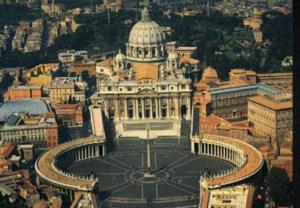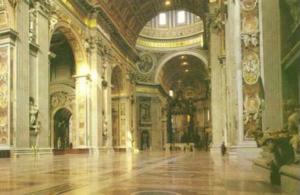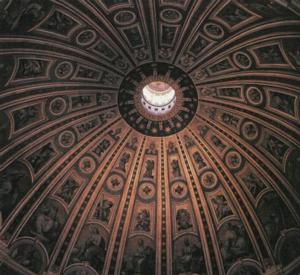
Church in the Vatican, Rome, built 1506 - 1615.
Saint Peter's Basilica, mostly known as Saint Peter's, is the main church of the Vatican in Rome (Italy) and the location for major addresses of the Pope. Construction of the original ("Old") Saint Peter's Basilica began between 326 and 333 under the Roman emperor Constantine and was completed some 30 years later. It had five aisles and was entered through an atrium called Paradise.
The basilica deteriorated over time, and in the 15th century Pope Nicholas V, advised by Battisa Alberti, proposed to replace it with a new building. Construction of the "New" Saint Peter's Basilica began on 18 April 1506, when Pope Julius II laid the first stone, and continued for over 100 years.
Supervision of the construction changed several times. The original design was by Donato Bramante. Raphael and Michelangelo were among the various architects that followed him. Bramante envisaged a church in the form of a Greek cross. Raphael changed the design to a Roman cross; Michelangelo continued with a Greek cross design. As it stands today, however, Saint Peter's has the form of a Roman cross with a length along the main axis of 187 m.
The New Saint Peter's Basilica was completed in 1615 under Pope Paul V. During 1655 - 1667 the architect Gian Lorenzo Bernini designed and built an elliptical piazza in front of the church, which gives the building majestic proportions.
Although plans for campaniles (church steeples or towers) were developed they were not followed through, and the appearance of the Basilica is dominated by its façade and its majestic dome, the largest such construction in the world rivalled in size only by the Gol Gumbaz in Bijapur (India).
The need to raise funds for the building of Saint Peter's was one of the factors that led to the Protestant reformation of Martin Luther. St Peter's remained the largest Christian church in the world until 1989, when a new basilica was completed in Yamoussoukro (Ivory Coast).


